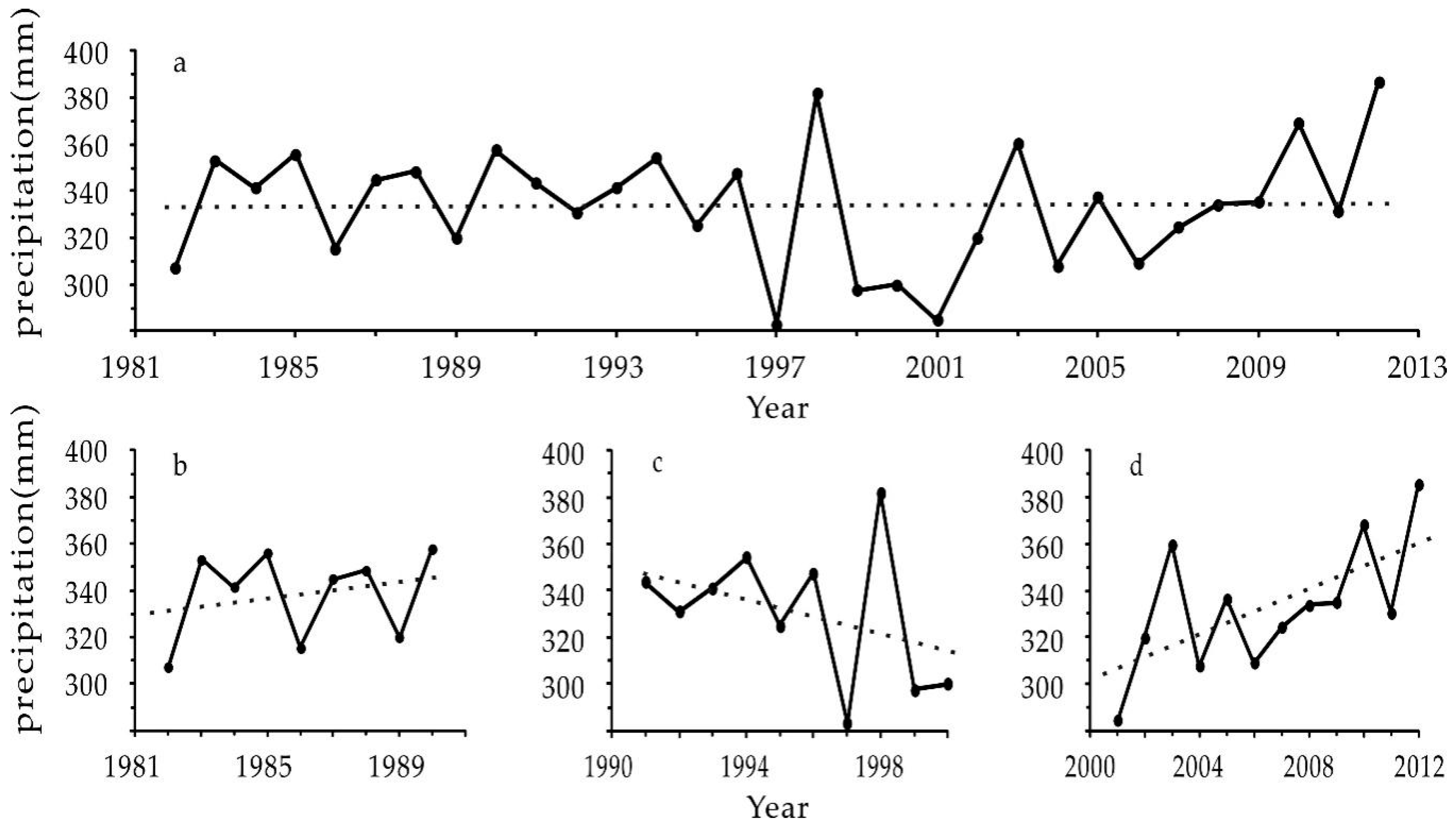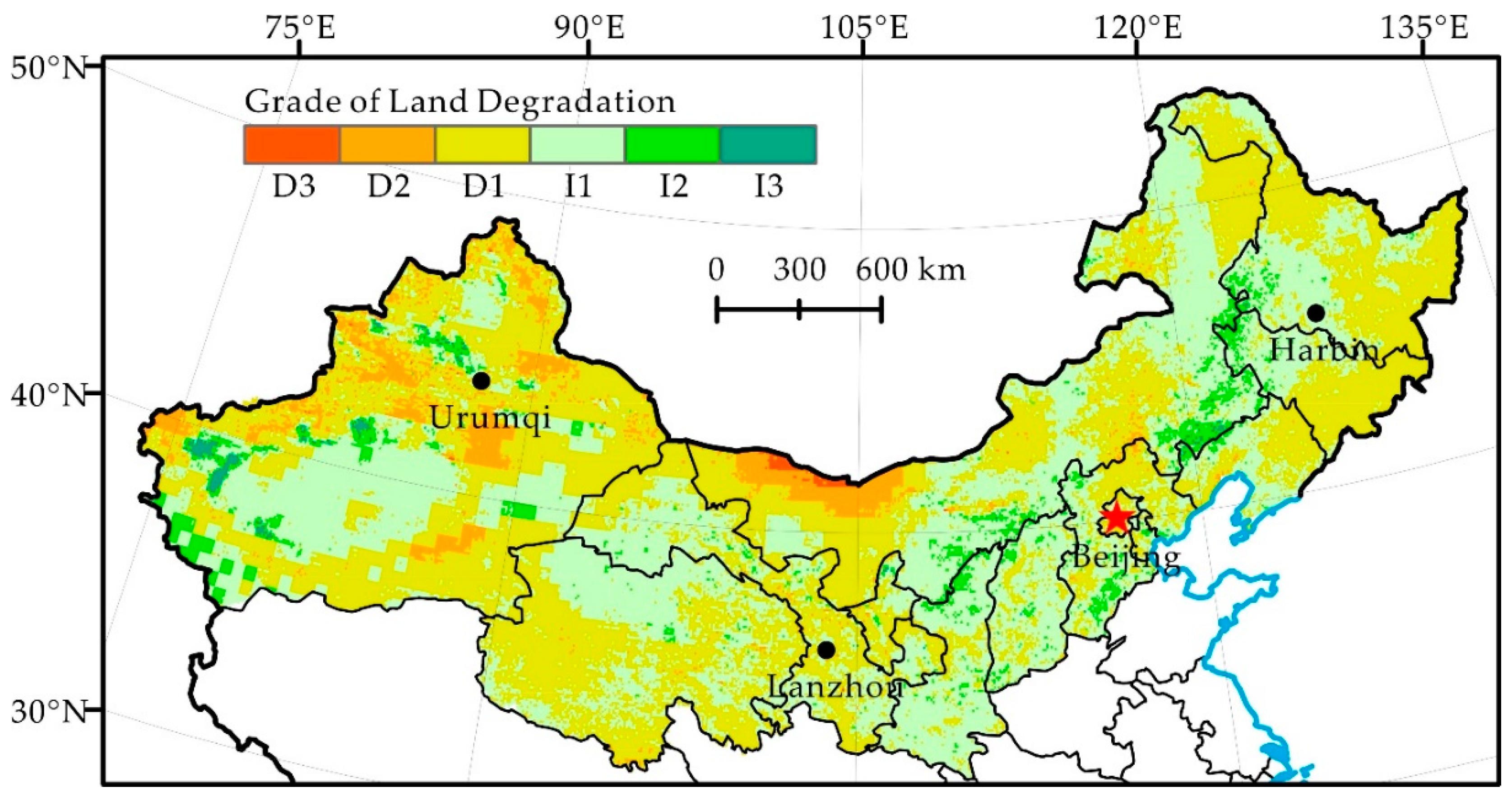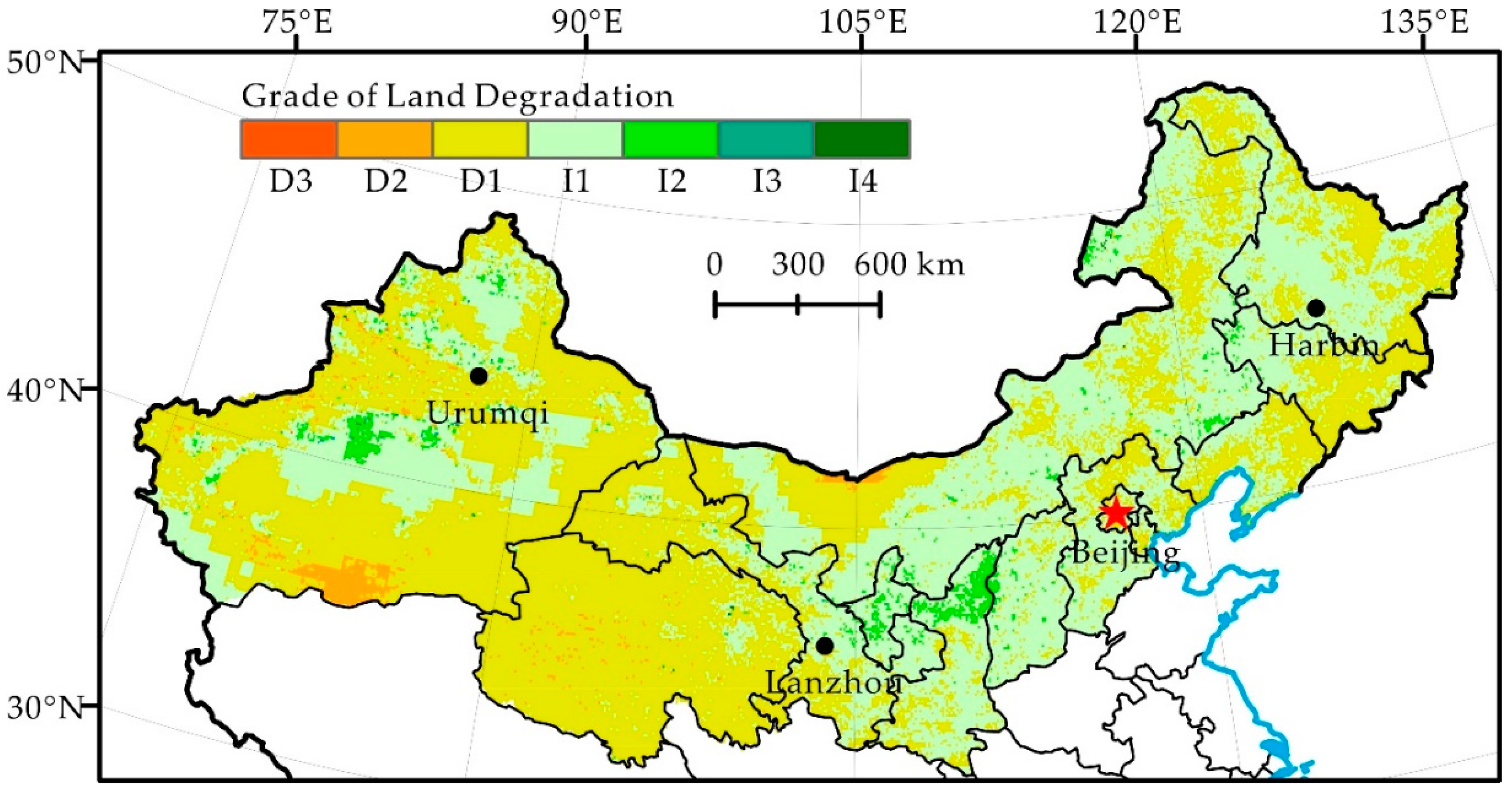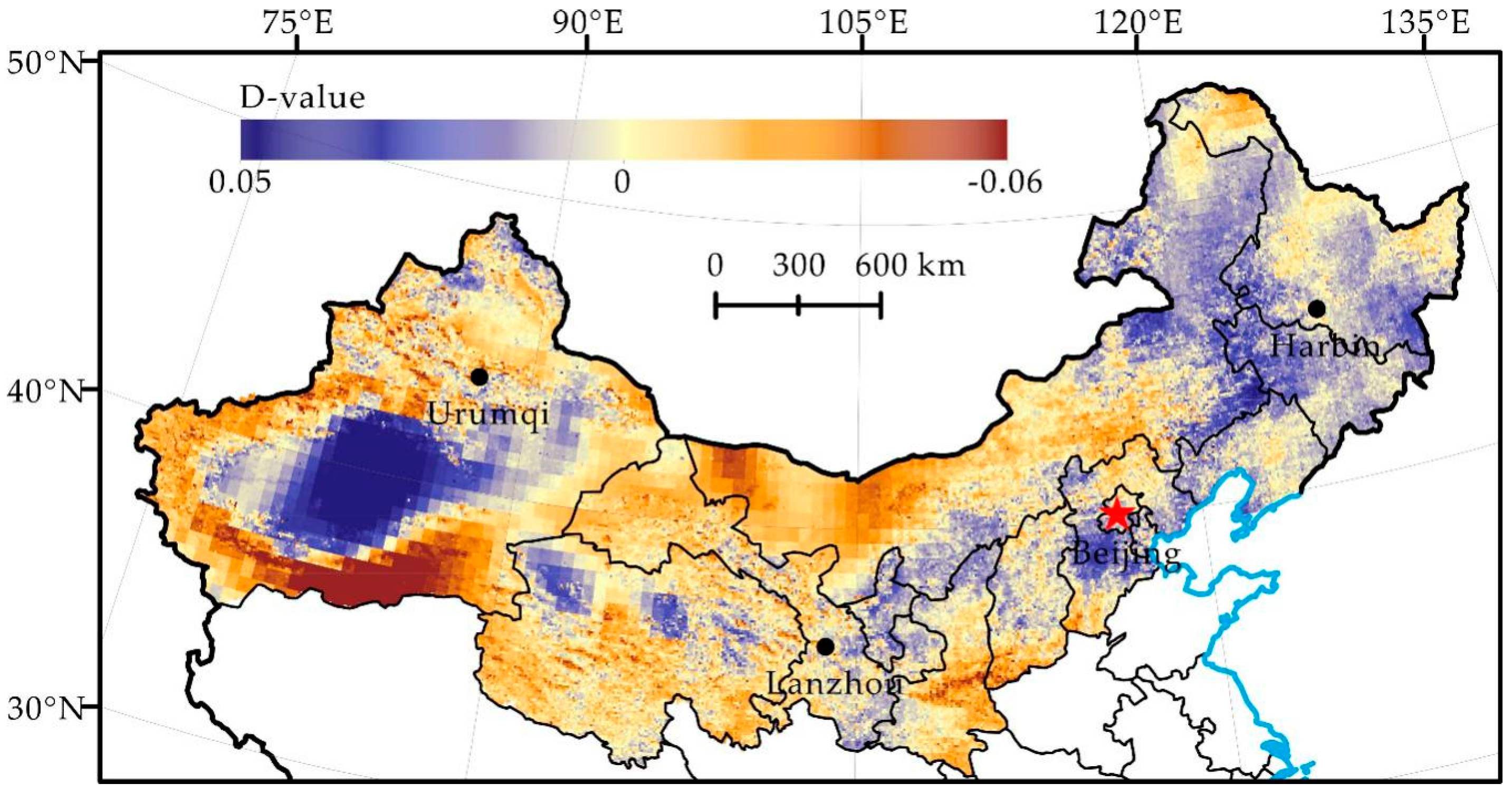Spatial-Temporal Pattern of Human-Induced Land Degradation in Northern China in the Past 3 Decades—RESTREND Approach
Abstract
:1. Introduction
2. Approaches and Data Sources
2.1. Overview of Study Areas
2.2. Detection Approach of Human-Induced Land Degradation
2.3. Data Source
3. Results
3.1. Precipitation Change Trend of Northern China in the Past 3 Decades
3.2. Estimated Result of NDVIpot and Detection in Northern China
3.3. Human-Induced Land Degradation Pattern of Northern China in the Past Three Decades
4. Discussion
4.1. Relationship between NDVI Residual and Land Degradation
4.2. Scale Effects in Terms of NDVI Pixel Size
4.3. Dynamics of Human-Induced Land Degradation in Northern China
4.4. Regional Differentiation of Human Factors in Land Degradation of Northern China
5. Conclusions
Author Contributions
Funding
Conflicts of Interest
Appendix A

| RMSE | 1982–1990 (%) | 1982–2000 (%) | 1982–2012 (%) |
|---|---|---|---|
| <0.25 | 81.5% | 81.4% | 80.8% |
| 0.25–0.5 | 18.2% | 18.2% | 18.8% |
| >0.5 | 0.3% | 0.4% | 0.4% |
References
- MEA (Millennium Ecosystem Assessment). Ecosystems and Human Well-Being: Synthesis; Island Press: Washington, DC, USA, 2005. [Google Scholar]
- Feng, Q.; Ma, H.; Jiang, X.; Wang, X.; Cao, S. What Has Caused Desertification in China? Sci. Rep. 2015, 5, 1–8. [Google Scholar] [CrossRef] [PubMed]
- Bai, Z.; Dent, D. Recent land degradation and improvement in China. Ambio 2009, 38, 150–156. [Google Scholar] [CrossRef] [PubMed]
- O’Callaghan, J.F. The Extraction of Drainage Networks from Digital Elevation Data. Comput. Vis. Graph. Image Process. 1984, 28, 323–344. [Google Scholar] [CrossRef]
- Chen, J.; Chen, J.Z.; Tan, M.Z.; Gong, Z.T. Soil degradation: A global problem endangering sustainable development. J. Geogr. Sci. 2002, 12, 243–252. [Google Scholar] [CrossRef]
- Webb, N.P.; Marshall, N.A.; Stringer, L.C.; Reed, M.S.; Chappell, A.; Herrick, J.E. Land degradation and climate change: Opportunities for building climate resilience in agriculture. Front. Ecol. Environ. 2017, 15, 450–459. [Google Scholar] [CrossRef]
- Vitousek, P.M.; Mooney, H.A.; Lubchenco, J.; Melillo, J.M. Human domination of earth’s ecosystems. Science 1997, 277, 494–499. [Google Scholar] [CrossRef]
- Yang, X.; Ding, Z.; Fan, X.; Zhou, Z.; Ma, N. Processes and mechanisms of desertification in northern China during the last 30 years, with a special reference to the Hunshandake Sandy Land, eastern Inner Mongolia. Catena 2007, 71, 2–12. [Google Scholar] [CrossRef]
- Wei, Z.; Gang, C.; Zhou, F.; Li, J.; Dong, X.; Zhao, C. Quantitative assessment of the individual contribution of climate and human factors to desertification in northwest China using net primary productivity as an indicator. Ecol. Indic. 2015, 48, 560–569. [Google Scholar] [CrossRef]
- Chen, Y.F.; Tang, H.P. Desertification in North China: Background, anthropogenic impacts and failure in combating. Land Degrad. Dev. 2005, 16, 367–376. [Google Scholar] [CrossRef]
- Winslow, M.D.; Vogt, J.V.; Thomas, R.J.; Sommer, S.; Martius, C.; Akhtar-Schuster, M. Science for improving the monitoring and assessment of dryland degradation. Land Degrad. Dev. 2011, 22, 145–149. [Google Scholar] [CrossRef] [Green Version]
- Hein, L.G.; Ridder, D.N.; Hiernaux, P.; Leemans, R.; De Wit, A.; Schaepman, M.E. Desertification in the Sahel: Towards better accounting for ecosystem dynamics in the interpretation of remote sensing images. J. Arid. Environ. 2011, 75, 1164–1172. [Google Scholar] [CrossRef]
- Desta, L.; Kassie, M.; Benin, S.; Pender, J. Land degradation and strategies for sustainable development in the Ethiopian highlands: Amhara region. Am. J. Agr. Econ. 2000, 83, 1231–1240. [Google Scholar]
- Zhu, Z.D.; Wu, H.Z.; Cui, S.H. Desertification/land degradation prevention and environmental protection in China. J. Ecol. Rural Environ. 1996, 12, 96. [Google Scholar]
- Albakri, J.; Saoub, H.; Nickling, W.; Suleiman, A.; Salahat, M.; Khresat, S.; Kandakji, T. Remote sensing indices for monitoring land degradation in a semiarid to arid basin in Jordan. Proc. Spie 2012, 8538, 1–10. [Google Scholar] [CrossRef]
- Yue, Y.J.; Shi, P.J.; Zou, X.Y.; Ye, X.Y.; Zhu, A.X.; Wang, J.A. The measurement of wind erosion through field survey and remote sensing: A case study of the Mu Us Desert, China. Nat. Hazards 2015, 76, 1497–1514. [Google Scholar] [CrossRef]
- Yue, Y.J.; Li, M.; Zhu, A.X.; Ye, X.Y.; Mao, R.; Wan, J.H.; Dong, J. Land Degradation Monitoring in the Ordos Plateau of China Using an Expert Knowledge and BP-ANN-Based Approach. Sustainability 2016, 8, 1174. [Google Scholar] [CrossRef] [Green Version]
- Lin, D.G.; Yu, H.; Lian, F.; Wang, J.A.; Zhu, A.X.; Yue, Y.J. Quantifying the hazardous impacts of human-induced land degradation on terrestrial ecosystems: A case study of karst areas of south China. Environ. Earth Sci. 2016, 75, 1–18. [Google Scholar] [CrossRef]
- Panigrahy, R.K.; Kale, M.P.; Dutta, U.; Mishra, A.; Banerjee, B.; Singh, S. Forest cover change detection of Western Ghats of Maharashtra using satellite remote sensing based visual interpretation technique. Curr. Sci. 2010, 98, 657–664. [Google Scholar] [CrossRef]
- Higginbottom, T.P.; Symeonakis, E. Assessing Land Degradation and Desertification Using Vegetation Index Data: Current Frameworks and Future Directions. Remote Sens. 2014, 6, 9552–9575. [Google Scholar] [CrossRef] [Green Version]
- Evans, J.; Geerken, R. Discrimination between climate and human-induced dryland degradation. J. Arid. Environ. 2004, 57, 535–554. [Google Scholar] [CrossRef]
- Wessels, K.J.; Prince, S.D.; Malherbe, J.; Small, J.; Frost, P.E.; Vanzyl, D. Can human-induced land degradation be distinguished from the effects of rainfall variability? A case study in South Africa. J. Arid. Environ. 2007, 68, 271–297. [Google Scholar] [CrossRef]
- Li, A.; Wu, J.; Huang, J. Distinguishing between human-induced and climate-driven vegetation changes: A critical application of RESTREND in Inner Mongolia. Landsc. Ecol. 2012, 27, 969–982. [Google Scholar] [CrossRef]
- Burrell, A.L.; Evans, J.P.; Yi, L. Detecting dryland degradation using Time Series Segmentation and Residual Trend analysis (TSS-RESTREND). Remote Sens. Environ. 2017, 197, 43–57. [Google Scholar] [CrossRef]
- Wessels, K.J.; Bergh, F.V.D.; Scholes, R.J. Limits to detectability of land degradation by trend analysis of vegetation index data. Remote Sens. Environ. 2012, 125, 10–22. [Google Scholar] [CrossRef]
- Li, X.B.; Li, R.H.; Li, G.Q.; Wang, H.; Li, Z.F.; Li, X.; Hou, X.Y. Human-induced vegetation degradation and response of soil nitrogen storage in typical steppes in Inner Mongolia, China. J. Arid. Environ. 2016, 124, 80–90. [Google Scholar] [CrossRef]
- Wang, X.M.; Chen, F.H.; Hasi, E.; Li, J.C. Desertification in China: An assessment. Earth-Sci. Rev. 2008, 88, 188–206. [Google Scholar] [CrossRef]
- Lu, J.F. Change of Land Degradation in South China and Impacts of Human Activities. Prog. Geogr. 1999, 18, 215–221. [Google Scholar] [CrossRef]
- Lin, N.F.; Tang, J. Geological environment and causes for desertification in arid-semiarid regions in China. Environ. Geol. 2002, 41, 806–815. [Google Scholar] [CrossRef]
- Tao, Z.; Wang, H.; Liu, Y.; Xu, Y.; Dai, J. Phenological response of different vegetation types to temperature and precipitation variations in northern China during 1982a-2012. Int. J. Remote Sens. 2017, 38, 3236–3252. [Google Scholar] [CrossRef]
- Liu, J.G.; Diamond, J. China’s environment in a globalizing world. Nature 2005, 435, 1179–1186. [Google Scholar] [CrossRef]
- Trabucco, A.; Zomer, R.J. Global Aridity Index and Potential Evapo-Transpiration (ET0) Climate Database v2. CGIAR Consortium for Spatial Information (CGIAR-CSI). Available online: https://figshare.com/articles/Global_Aridity_Index_and_Potential_Evapotranspiration_ET0_Climate_Database_v2/7504448/1 (accessed on 25 June 2019).
- Han, R.M.; Liu, P.; Ma, C.; Ma, C.R. NDVI 3g dynamics and climate response of vegetation in Ordos. Bull. Soil Water Conserv. 2016, 36, 28–33. [Google Scholar] [CrossRef]
- Beck, P.S.A.; Goetz, S.J. Satellite observations of high northern latitude vegetation productivity changes between 1982 and 2008: Ecological variability and regional differences. Environ. Res. Lett. 2011, 6, 45501–45510. [Google Scholar] [CrossRef]
- Lin, Z.; Gong, H.; Dai, Z.; Xu, T.; Su, X. An integrated assessment of the impact of precipitation and groundwater on vegetation growth in arid and semiarid areas. Environ. Earth Sci. 2015, 74, 5009–5021. [Google Scholar] [CrossRef] [Green Version]
- He, Y. The effect of precipitation on vegetation cover over three landscape units in a protected semi-arid grassland: Temporal dynamics and suitable climatic index. J. Arid. Environ. 2014, 109, 74–82. [Google Scholar] [CrossRef] [Green Version]
- Rutherford, M.C. Annual Plant Production Precipitation Relations in Arid and Semi-Arid Regions. S. Afr. J. Sci. 1980, 76, 53–56. [Google Scholar]
- Wang, T.; Wei, W.U.; Xue, X.; Sun, Q.; Chen, G. Study of spatial distribution of sandy desertification in North China in recent 10 years. Sci. China Ser. D Earth Sci. 2004, 47, 78–88. [Google Scholar] [CrossRef]
- Yang, C.F. Land degradation in China and its countermeasures. China Environ. Sci. 1997, 17, 108–112. [Google Scholar]
- Zhang, T.R.; Chai, X.M.; Li, Z.Z. Vegetation coverage characteristics in northern China and its relationship with sandstorms. Plateau Meteorol. 2010, 29, 137–145. [Google Scholar]
- Liu, S.; Wang, T.; Kang, W.; David, M. Several challenges in monitoring and assessing desertification. Environ. Earth Sci. 2015, 73, 7561–7570. [Google Scholar] [CrossRef]
- Zhai, P.; Zhang, X.; Wan, H.; Pan, X. Trends in Total Precipitation and Frequency of Daily Precipitation Extremes over China. J. Clim. 2005, 18, 1096–1108. [Google Scholar] [CrossRef]
- Ma, G.X.; Shi, M.J.; Zhao, X.T.; Wang, T. Monetary assessment of economic losses caused by desertification in northern China. J. Desert Res. 2008, 28, 627–633. [Google Scholar]
- Li, Z.P.; Yue, L.P.; Guo, L.; Liu, S.Y.; Wang, M.; Nie, H.G.; Yang, L.R.; Sun, H.; Wang, F.Y. Holocene climate change and desertification in Northern China. Northwestern Geol. 2007, 40, 1–29. [Google Scholar] [CrossRef]
- Xu, C.; Chen, Y.; Li, W.; Chen, Y. Climate change and hydrologic process response in the Tarim River Basin over the past 50 years. Chin. Sci. Bull. 2006, 51, 25–36. [Google Scholar] [CrossRef]
- Tao, H.; Gemmer, M.; Bai, Y.; Su, B.; Mao, W. Trends of streamflow in the Tarim River Basin during the past 50 years: Human impact or climate change? J. Hydrol. 2011, 400, 1–9. [Google Scholar] [CrossRef]
- Jiang, L.W.; Tong, Y.F.; Zhao, Z.J.; Li, T.H.; Liao, J.H. Water Resources, Land Exploration and Population Dynamics in Arid Areas: The Case of the Tarim River Basin in Xinjiang of China. Popul. Env. 2005, 26, 471–503. [Google Scholar] [CrossRef]
- Wang, T.; Yan, C.Z.; Song, X.; Li, S. Landsat images reveal trends in the aeolian desertification in a source area for sand and dust storms in China’s Alashan Plateau (1975-2007). Land Degrad Dev. 2013, 24, 422–429. [Google Scholar] [CrossRef]
- Mu, S.J.; Chen, Y.Z.; Li, J.L.; Ju, W.M.; Odeh, I.O.A.; Zou, X.L. Grassland dynamics in response to climate change and human activities in Inner Mongolia, China between 1985 and 2009. Rangel. J. 2013, 35, 315–329. [Google Scholar] [CrossRef]
- Qiu, S.W.; Zhang, B.; Wang, Z.C. A study on the status, causes and treatment of desertification in the western part of the northeast plain of China. Quat. Sci. 2005, 25, 63–73. [Google Scholar] [CrossRef]
- Wang, F.; Pan, X.; Wang, D.; Shen, C.; Lu, Q. Combating desertification in China: Past, present and future. Land Use Pol. 2013, 31, 311–313. [Google Scholar] [CrossRef]
- Shen, Y.N.; Qiu, M.M.; Yue, Y.J. Risk assessment of desertification in northern China. Arid Zone Res. 2017, 1, 174–184. [Google Scholar] [CrossRef]
- Wang, T.; Xue, X.; Zhou, L.; Guo, J. Combating Aeolian Desertification in Northern China. Land Degrad. Dev. 2015, 26, 118–132. [Google Scholar] [CrossRef]
- Cao, S.; Liu, Y.; Yu, Z. China’s Successes at Combating Desertification Provide Roadmap for Other Nations. Environ. Sci. Policy Sustain. Dev. 2018, 60, 16–24. [Google Scholar] [CrossRef]








| No. | Unary Linear Regression Slope of Residual | Land Degradation Degree |
|---|---|---|
| D4 | −0.06~−0.03 | Extremely severe degradation |
| D3 | −0.03~−0.01 | Severe degradation |
| D2 | −0.01~−0.005 | Moderate degradation |
| D1 | −0.005~0 | Slight degradation |
| I1 | 0~0.005 | Slight restoration |
| I2 | 0.005~0.01 | Moderate restoration |
| I3 | 0.01~0.03 | Significant restoration |
| I4 | 0.03~0.06 | Extremely significant restoration |
| Years | x (Optimal Cumulative Precipitation) | R2 | a | b | F | Sig. |
|---|---|---|---|---|---|---|
| 1982 | Ln (January–December) | 0.628 | 0.250 | −0.882 | 3336.877 | <0.001 |
| 1983 | Ln (January–December) | 0.615 | 0.228 | −0.778 | 3154.693 | <0.001 |
| 1984 | Ln (April–October) | 0.672 | 0.244 | −0.842 | 4053.405 | <0.001 |
| 1985 | Ln (January–December) | 0.588 | 0.196 | −0.595 | 2821.242 | <0.001 |
| 1986 | Ln (January–December) | 0.594 | 0.216 | −0.680 | 2891.950 | <0.001 |
| 1987 | Ln (January–December) | 0.693 | 0.275 | −1.039 | 4463.948 | <0.001 |
| 1988 | Ln (April–July) | 0.692 | 0.302 | −1.008 | 4454.531 | <0.001 |
| 1989 | Ln (March–July) | 0.590 | 0.233 | −0.661 | 2842.146 | <0.001 |
| 1990 | Ln (January–December) | 0.695 | 0.266 | −0.977 | 4499.123 | <0.001 |
| 1991 | Ln (January–December) | 0.633 | 0.246 | −0.869 | 3409.689 | <0.001 |
| 1992 | Ln (January–December) | 0.614 | 0.264 | −0.977 | 3149.731 | <0.001 |
| 1993 | Ln (January–December) | 0.694 | 0.280 | −1.061 | 4498.016 | <0.001 |
| 1994 | Ln (January–December) | 0.610 | 0.223 | −0.731 | 3095.045 | <0.001 |
| 1995 | Ln (March–July) | 0.694 | 0.242 | −0.659 | 4483.983 | <0.001 |
| 1996 | Ln (January–December) | 0.578 | 0.249 | −0.893 | 2705.651 | <0.001 |
| 1997 | Ln (January–December) | 0.617 | 0.247 | −0.852 | 3187.335 | <0.001 |
| 1998 | Ln (January–December) | 0.675 | 0.262 | −0.984 | 4118.550 | <0.001 |
| 1999 | Ln (January–December) | 0.567 | 0.250 | −0.851 | 2588.770 | <0.001 |
| 2000 | Ln (January–December) | 0.610 | 0.249 | −0.858 | 3091.149 | <0.001 |
| 2001 | Ln (March–July) | 0.627 | 0.214 | −0.513 | 3332.700 | <0.001 |
| 2002 | Ln (January–December) | 0.570 | 0.279 | −1.067 | 2619.403 | <0.001 |
| 2003 | Ln (January–December) | 0.645 | 0.264 | −0.996 | 3601.928 | <0.001 |
| 2004 | Ln (January–December) | 0.612 | 0.239 | −0.811 | 3121.737 | <0.001 |
| 2005 | Ln (January–December) | 0.635 | 0.283 | −1.088 | 3438.869 | <0.001 |
| 2006 | Ln (March–July) | 0.721 | 0.266 | −0.811 | 5112.385 | <0.001 |
| 2007 | Ln (January–December) | 0.508 | 0.236 | −0.820 | 2045.391 | <0.001 |
| 2008 | Ln (January–December) | 0.580 | 0.254 | −0.914 | 2733.455 | <0.001 |
| 2009 | Ln (January–December) | 0.614 | 0.225 | −0.719 | 3142.520 | <0.001 |
| 2010 | Ln (March-August) | 0.609 | 0.266 | −0.889 | 3082.357 | <0.001 |
| 2011 | Ln (March–July) | 0.638 | 0.273 | −0.829 | 3490.340 | <0.001 |
| 2012 | Ln (January–December) | 0.638 | 0.273 | −1.028 | 3494.115 | <0.001 |
| ID | 1982–1990 (%) | 1982–2000 (%) | 1982–2012 (%) | Land Degradation Degree |
|---|---|---|---|---|
| D4 | 1.3 | 0 | 0 | Extremely severe degradation |
| D3 | 8.5 | 0.3 | 0.01 | Severe degradation |
| D2 | 17.1 | 5.1 | 1.38 | Moderate degradation |
| D1 | 25.6 | 46.8 | 51.66 | Slight degradation |
| I1 | 23.5 | 42.9 | 44.77 | Slight restoration |
| I2 | 15.0 | 4.5 | 2.05 | Moderate restoration |
| I3 | 8.3 | 0.4 | 0.07 | Significant restoration |
| I4 | 0.6 | 0 | 0.05 | Extremely significant restoration |
© 2019 by the authors. Licensee MDPI, Basel, Switzerland. This article is an open access article distributed under the terms and conditions of the Creative Commons Attribution (CC BY) license (http://creativecommons.org/licenses/by/4.0/).
Share and Cite
Zhuge, W.; Yue, Y.; Shang, Y. Spatial-Temporal Pattern of Human-Induced Land Degradation in Northern China in the Past 3 Decades—RESTREND Approach. Int. J. Environ. Res. Public Health 2019, 16, 2258. https://doi.org/10.3390/ijerph16132258
Zhuge W, Yue Y, Shang Y. Spatial-Temporal Pattern of Human-Induced Land Degradation in Northern China in the Past 3 Decades—RESTREND Approach. International Journal of Environmental Research and Public Health. 2019; 16(13):2258. https://doi.org/10.3390/ijerph16132258
Chicago/Turabian StyleZhuge, Wenyi, Yaojie Yue, and Yanrui Shang. 2019. "Spatial-Temporal Pattern of Human-Induced Land Degradation in Northern China in the Past 3 Decades—RESTREND Approach" International Journal of Environmental Research and Public Health 16, no. 13: 2258. https://doi.org/10.3390/ijerph16132258





